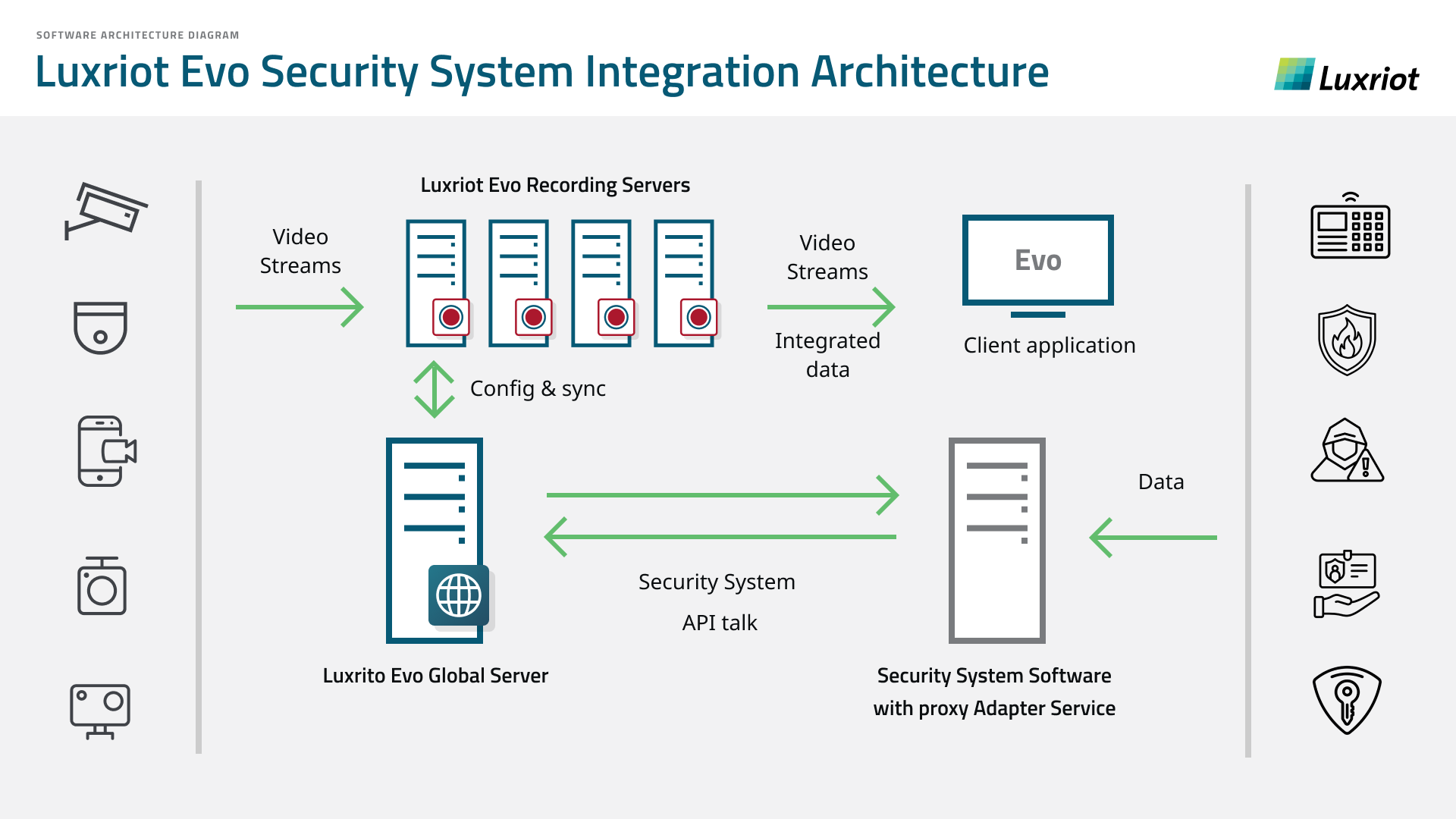Plug, Play, Protect: Integrating Security Systems with Luxriot Evo
As security infrastructure becomes increasingly interconnected, the ability to integrate systems efficiently and securely is more than a convenience—it’s an operational requirement. Our recent developments serve some of these needs, but there are so much more systems out there to be covered. The good news: with Luxriot Evo version 1.30, integration just became significantly more straightforward.
Let us introduce the designated “Security Systems” API, now publicly available : a streamlined way to connect third-party systems like access controls (AC), security panels (SP), fire panels (FP), and beyond.
This guide outlines the integration approach using the mentioned API, and introduces the supporting resources available on GitHub to help integrators and developers build and test their solutions with minimal overhead.
Why Sync Your Security Systems with Luxriot Evo?
Direct integration of the security and safety systems with Luxriot Evo isn’t just about convenience — it is a strategic move boosting your security capabilities. Key benefits include:
- Real-Time Monitoring: Stay on top of your security and safety effortlessly by accessing all events from one place - Luxriot Evo Monitor.
- Centralized Security: Arm partitions, lock doors, or manage sensors swiftly from a single platform.
- Scalable Design: Luxriot Evo adapts and grows alongside your security landscape.
- Cross-System Compatibility: This API is designed to work across different hardware and protocols, provided the system supports the required endpoints.
GitHub Goldmine: What’s Available for Developers?
To make your integration process as smooth as possible, we have published a set of tools and resources in the publicly available repository:
- Generic Access Control Adapter API Documentation: This repository provides comprehensive documentation outlining the API structure, endpoint definition, request/response formats, and implementation guidance — ideal for quickly getting familiar with it.
- Access Control Adapter Sample: A practical, fully functional example of the software-to-software adapter implementation. Use it as a template or reference to jump-start your own integration project to quickly grasp best practices, test functionality, and adapt the code effectively to your unique requirements.
- Simple Access Control Emulator: A basic emulator that simulates an actual security system behavior, including event generation. This helps validate the integration in a controlled yet authentic setting.
All three are intended to reduce setup time, increase consistency, and ensure testability in development workflows.

Security system integration workflow
Step-by-Step: From Git to Live
Follow these straightforward steps to kickstart your API integration journey:
- Clone the Repositories: Head over to our GitHub repository and grab the provided resources.
- Run the Emulator: The SimpleAccessControlEmulator will help you set up a realistic testing environment and test responses from your integrtion.
- Review the Sample Adapter: Modify the AccessControlAdapterSample to fit your actual security system's architecture and features.
- Test, Test, and Test: Thoroughly test your setup by simulating common use cases; stress-test your implementation, and verify performance across typical scenarios your customer requests.
Integration Essentials: What You Need to Know
Your security system must support these essential REST endpoints for full interoperability with Luxriot Evo:
/info– Basic system info, supported featured, and your unique integrator ID./v1/users– User (cardholder) information, including optional image data./v1/events– Event feed for real-time monitoring./v1/actions– Trigger system actions like lock/unlock, bypass, etc./v1/parameters– Adjust system settings such as PIN codes or access permissions./v1/items– Manage and observe states of doors, partitions, zones, and outputs./v1/states– Current system state information for all components./v1/notifications– Server-Sent Events (SSE) for live updates from the system.
If the target security system has closed architecture or only supports lower level protocols, you will need to implement a proxy service (adapter) that will communicate to both systems.
Understanding API Responses
All API responses follow a consistent and clean JSON structure to ensure clarity in parsing and handling. For example:
{
"page": null,
"nextPage": null,
"error": null,
"errorMessage": null,
"data": {}
}
Securing the Connection: What You Need to Enable Integration
To ensure safe and successful communication between Luxriot Evo and your external systems, don't forget to take care about the licensing:
1. Obtain and Use a Unique Integrator ID (GUID)
Every integration requires a unique Integrator ID, issued directly by Luxriot (subject to a non-disclosure agreement. After you receive it, embed this GUID into your adapter or third-party system: without it, Luxriot Evo will not recognize the 3rd party and won't be able to establish the connection. The GUID acts as an authorization token, ensuring that only trusted systems can communicate with the VMS.
To get your GUID, please contact the Luxriot team or your account representative.
2. Activate the Appropriate License Option
In addition to the GUID, the "Security System Integrations" feature must be enabled in your Luxriot Evo license. This applies to both end-user production environments and development/testing systems.
Without this license option, Evo will reject connections from adapter services, even if technically valid. So, don't forget to specify the need to use a particular integration when purchasing your Evo license.
Join the Integration Community
We warmly invite you to explore our comprehensive API resources, integrate your AC, SP, and FP systems smoothly, and enhance your security management with Luxriot Evo. Whether you are integrating a standalone door controller or a full building management system, our support engineers will be happy to help!
Explore the resources, experiment with the emulator, and contribute to a growing community of integrators working to unify safety and security under one roof.


